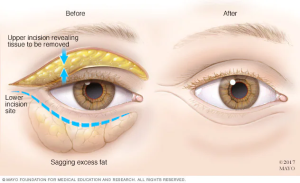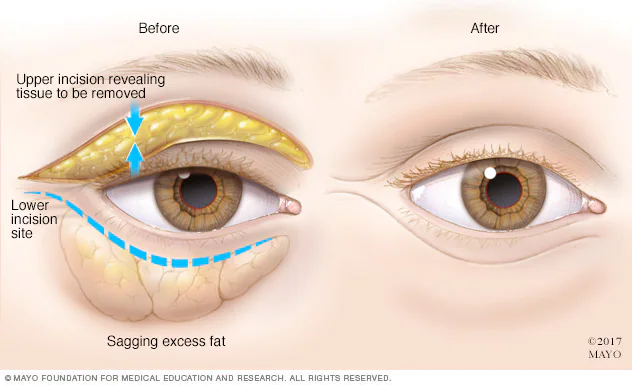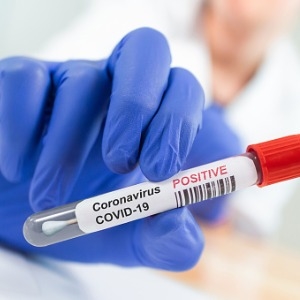Blepharoplasty: Eyes Surgery
Besides making you look older, severely sagging skin around your eyes can reduce your side vision (peripheral vision), especially the upper and outer parts of your field of vision. Blepharoplasty can reduce or eliminate these vision problems and make your eyes appear younger and more alert.

How do I know if I need surgery for my eyes?
Eyelid surgery is a common procedure that involves lifting and tightening the skin around the eyes. Loose, sagging, or puffy skin around the eyes can affect the appearance of the lower and upper eyelids. In some cases, individuals have problems with both areas of the eyes. By removing this excess skin or puffiness, Jacksonville men and women can have a more refreshed, youthful appearance, and, in some cases, help improve a person’s ability to see.
Here are some typical signs it may be time to see a plastic surgeon about eyelid surgery and questions to consider prior to the consultation:
Eyes always look tired or puffy, even with plenty of sleep?
Always have bags under your eyes?
Do your lower eyelids sag down that the whites of your iris consistently show?
Does the skin on your upper eyelids sag?
Have trouble seeing because your upper eyelids droop down so far?
Upper eyelids feel heavy, making it challenging to keep your eyes open?

What can you expect from the eye surgery?
Before the procedure
Blepharoplasty is usually done in an outpatient setting. Your surgeon injects numbing medication into your eyelids and administers intravenous medication to help you relax.
During the procedure
If you have surgery on your upper and lower eyelids, the surgeon generally works on your upper lids first. He or she cuts along the fold of the eyelid, removes some excess skin, muscle and possibly fat, and closes the cut.
On the lower lid, the surgeon makes a cut just below the lashes in your eye’s natural crease or inside the lower lid. He or she removes or redistributes excess fat, muscle and sagging skin, and closes the cut.
If your upper eyelid droops close to your pupil, your surgeon may do blepharoplasty with a procedure called ptosis (TOE-sis) that provides additional support to the eyebrow muscle.
After the eye surgery
After surgery you spend time in a recovery room, where you are monitored for complications. You can leave later that day to recuperate at home.
After surgery you may temporarily experience:
- Blurred vision from the lubricating ointment applied to your eyes
- Watering eyes
- Light sensitivity
- Double vision
- Puffy, numb eyelids
- Swelling and bruising similar to having black eyes
- Pain or discomfort
Your doctor will likely suggest you take the following steps after surgery:
- Use ice packs on your eyes for 10 minutes every hour the night after surgery. The following day use ice packs on your eyes four to five times throughout the day.
- Gently clean your eyelids and use prescribed eyedrops or ointments.
- Avoid straining, heavy lifting and swimming for a week.
- Don’t engage in strenuous activities, such as aerobics and jogging, for a week.
- Avoid smoking.
- Avoid rubbing your eyes.
- If you use contact lenses, don’t put them in for about two weeks after surgery.
- Wear darkly tinted sunglasses to protect the skin of your eyelids from sun and wind.
- Sleep with your head raised higher than your chest for a few days.
- Apply cool compresses to reduce swelling.
- After a few days, return to the doctor’s office to have stitches removed, if needed.
- For about a week, avoid aspirin, ibuprofen (Advil, Motrin IB, others), naproxen sodium (Aleve, others), naproxen (Naprosyn), and other medications or herbal supplements that may increase bleeding. If needed, use acetaminophen (Tylenol, others) to control pain.
Seek medical attention immediately if you experience any of the following:
- Shortness of breath
- Chest pain
- An unusual heart rate
- Severe new eye pain
- Bleeding
- Vision problems
How should I prepare for the eye surgery?
Before scheduling blepharoplasty, you will meet with a plastic surgeon and an eye specialist (ophthalmologist) or a plastic surgeon who specializes in eye surgeries (oculoplastic surgeon) to discuss:
Your medical history: Your surgeon will ask questions about previous surgeries and past or current conditions, such as dry eyes, glaucoma, allergies, circulatory problems, thyroid problems and diabetes. Your doctor will also ask about your use of medications, vitamins, herbal supplements, alcohol, tobacco and drugs.
Your expectations: An honest discussion of your hopes and motivation for surgery will help set the stage for a satisfactory outcome. Your surgeon will discuss with you whether the procedure is likely to work well for you.
Before your eyelid surgery, you’ll undergo:
A physical examination: Your surgeon will conduct a physical examination, which may include testing your tear production and measuring parts of your eyelids.
A vision examination: Your eye doctor will examine your eyes and test your vision, including your peripheral vision. This is needed to support an insurance claim.
Eyelid photography: Your eyes will be photographed from different angles. These photos help with planning the surgery, assessing its immediate and long-term effects, and supporting an insurance claim.
And you’ll be asked to:
- Stop taking medication or herbal supplement associated with increased bleeding. Only take medications approved by your surgeon.
- Quit smoking several weeks before your surgery.
- Arrange for someone to drive you to and from surgery if you’re having outpatient surgery. Plan to have someone stay with you for the first night after returning home from surgery.
Results of the eye surgery
Many people express satisfaction with the results of blepharoplasty, such as a more rested and youthful appearance and more self-confidence. For some people, results of surgery may last a lifetime. For others, droopy eyelids may recur.
Bruising and swelling generally subside in 10 to 14 days, which may be when you feel comfortable going out in public again. Scars from the surgical cuts may take months to fade. Take care to protect your delicate eyelid skin from too much sun exposure.
Citations & Sources:
Mayoclinic.org. 2021. Blepharoplasty – Mayo Clinic. [online] Available at: <https://www.mayoclinic.org/tests-procedures/blepharoplasty/about/pac-20385174> [Accessed 28 October 2021].
Contoura.com. 2021. How Do I Know If I Need Blepharoplasty?. [online] Available at: <https://contoura.com/blog/how-do-i-know-if-i-need-blepharoplasty> [Accessed 28 October 2021].
















Thank you for sharing your article about blepharoplasty, or eyelid surgery, on Travocure’s website. Eyelid surgery is indeed a popular cosmetic procedure aimed at enhancing the appearance of the eyes and rejuvenating the surrounding area.
Your article provides a concise overview of blepharoplasty, its purposes, and the techniques involved. It mentions how this procedure can address various concerns such as excess skin, puffiness, bags under the eyes, and even droopy eyelids. By removing or repositioning the excess tissue, eyelid surgery can help create a more youthful and refreshed look.